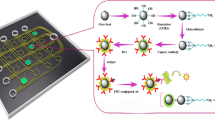Abstract
We use magnetic microbeads, which are magnetically self-assembled in chains in a microfluidic chip, as reaction substrates to implement two different sandwich immunoassay protocols for the detection of mouse monoclonal target antibodies. The magnetic chains form when the chip is placed in a magnetic field, and are geometrically trapped and accurately positioned in a microchannel with periodically enlarged cross-sections. In the first immunoassay protocol, capture and target antibodies are incubated off-chip, while exposure to the detection antibody is performed on-chip. In the second protocol, the complete immunoassay is fully executed on-chip. In the ‘off-chip incubation–on-chip detection’ protocol, antibodies can be detected down to a concentration of 50 ng/mL in a total assay time of 120 min, while consuming 1.5 mL of target antibody solution. Using the full on-chip protocol, our system is able to detect target antibodies in the range of a few ng/mL in 30 min, using only a few tens of nanoliters of target antibody solution and reagents. The ‘off-chip incubation–on-chip detection’ protocol is also applied for dosing antibodies obtained from the supernatant of a cell culture medium.







Similar content being viewed by others
References
Andersson H, van der Wijngaart W et al (2000) Micromachined flow-through filter-chamber for chemical reactions on beads. Sens Actuators B Chem 67(1–2):203–208
Bronzeau S, Pamme N (2008) Simultaneous bioassays in a microfluidic channel on plugs of different magnetic particles. Anal Chim Acta 609(1):105–112
Choi JW, Oh KW et al (2002) An integrated microfluidic biochemical detection system for protein analysis with magnetic bead-based sampling capabilities. Lab Chip 2(1):27–30
Deng T, Prentiss M et al (2002) Fabrication of magnetic microfiltration systems using soft lithography. Appl Phys Lett 80(3):461–463
Doyle PS, Bibette J et al (2002) Self-assembled magnetic matrices for DNA separation chips. Science 295(5563):2237
Gijs MAM (2004) Magnetic bead handling on-chip: new opportunities for analytical applications. Microfluidics Nanofluidics 1(1):22–40
Hayes MA, Polson NA et al (2001) Flow-based microimmunoassay. Anal Chem 73(24):5896–5902
Helseth LE (2005) Self-assembly of colloidal pyramids in magnetic fields. Langmuir 21(16):7276–7279
Herrmann M, Veres T et al (2006) Enzymatically-generated fluorescent detection in micro-channels with internal magnetic mixing for the development of parallel microfluidic ELISA. Lab Chip 6(4):555–560
Herrmann M, Roy et al (2007) Microfluidic ELISA on non-passivated PDMS chip using magnetic bead transfer inside dual networks of channels. Lab Chip 7(11)1546–1552
Lacharme F, Vandevyver C et al (2008a) Magnetic beads retention device for on-chip sandwich immuno-assay. In: Mems 2008: 21st IEEE international conference on micro electro mechanical systems, technical digest, pp 184–187
Lacharme F, Vandevyver C et al (2008b) Full on-chip nanoliter immunoassay by geometrical magnetic trapping of nanoparticle chains. Anal Chem 80(8):2905–2910
Lund-Olesen T, Bruus H et al (2007) Quantitative characterization of magnetic separators: comparison of systems with and without integrated microfluidic mixers. Biomed Microdevices 9(2):195–205
Manz A, Graber N et al (1990) Miniaturized total chemical-analysis systems—a novel concept for chemical sensing. Sens Actuators A 10(1–6):244–248
Pavius M, Hibert C et al (2004) Profile angle control in SIO2 deep anisotropic dry etching for MEMS fabrication. In: Mems 2004: 17th IEEE international conference on micro electro mechanical systems, technical digest, pp 669–672
Peyman SA, Lies A et al (2008) Rapid on-chip multi-step (bio)chemical procedures in continuous flow—manoeuvring particles through co-laminar reagent streams. Chem Commun 10:1220–1222
Plessers L, Bosmans E et al (1990) Production and immunohistochemical reactivity of mouse antiepithelial monoclonal-antibodies raised against human breast-cancer cells. Anticancer Res 10(1):271–277
Rida A, Gijs MAM (2004) Manipulation of self-assembled structures of magnetic beads for microfluidic mixing and assaying. Anal Chem 76(21):6239–6246
Rida A, Fernandez V et al (2003) Long-range transport of magnetic microbeads using simple planar coils placed in a uniform magnetostatic field. Appl Phys Lett 83(12):2396–2398
Sato K, Tokeshi M et al (2001) Determination of carcinoembryonic antigen in human sera by integrated bead bed immunoasay in a microchip for cancer diagnosis. Anal Chem 73(6):1213–1218
Shui LL, Eijkel JCT et al (2007) Multiphase flow in micro- and nanochannels. Sens Actuators B Chem 121(1):263–276
Siegel AC, Shevkoplyas SS et al (2006) Cofabrication of electromagnets and microfluldic systems in poly(dimethylsiloxane). Angew Chem Int Ed 45(41):6877–6882
Slovakova M, Minc N et al (2005) Use of self assembled magnetic beads for on-chip protein digestion. Lab Chip 5(9):935–942
Smistrup K, Kjeldsen BG et al (2005) On-chip magnetic bead microarray using hydrodynamic focusing in a passive magnetic separator. Lab Chip 5(11):1315–1319
Author information
Authors and Affiliations
Corresponding author
Rights and permissions
About this article
Cite this article
Lacharme, F., Vandevyver, C. & Gijs, M.A.M. Magnetic beads retention device for sandwich immunoassay: comparison of off-chip and on-chip antibody incubation. Microfluid Nanofluid 7, 479 (2009). https://doi.org/10.1007/s10404-009-0424-7
Received:
Accepted:
Published:
DOI: https://doi.org/10.1007/s10404-009-0424-7




